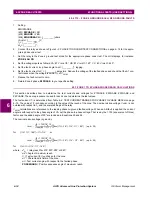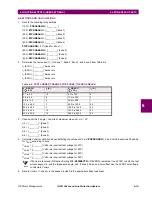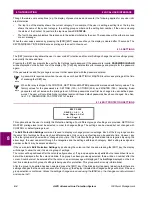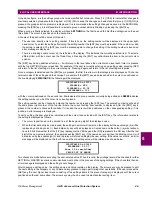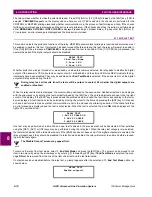
8-6
ALPS Advanced Line Protection System
GE Power Management
8.1 INTRODUCTION
8 LOCAL USER INTERFACE
8
If the [SET] key is pressed again, the setting category screen will be displayed. If the [SET] key is pressed for the third time,
the group selection display will appear with the current group number blinking. If any of the other Command keys are
pressed, the command menu associated with the Command key will be displayed.
Note that the ALPS continues its protection activities while setting values are being entered. Entered settings are stored in
a temporary buffer until the user presses [END] and selects one of the save settings items. This will cause a transfer of set-
tings from the buffer to EEPROM and the protection to re-initialize, if there is not a fault in progress at that time. If the set-
tings are not saved and the relay is allowed to time out (15 minutes), all of the settings in temporary storage will be lost.
As soon as the first valid setting change has been made, the ALPS Status LED starts blinking as reminder to save the set-
tings. It continues to blink until the settings are saved or the relay times out (15 minutes). As a safeguard, the following
message will be displayed whenever the [ACT] or [INF] keys are pressed after changing but not saving settings.
At this point the user can press the [END] key to save the changed settings in EEPROM. The user may also press the
[ACT] or [INF] keys to proceed with other operations. The setting changes will continue to reside in temporary memory until
the user presses the [END] key or the relay times out.
8.1.7 [END] KEY
The [END] key has two purposes. The first is to transfer settings changes from the temporary area into the correct group.
The other is to return the user to the VIEW or default privilege level. Each function can be accomplished without the other.
If no settings changes have been made, the only option when pressing [END] is Quit. This returns to the default privilege
level. If settings changes were made, then three choices are available:
1.
Save set & quit – The edited settings are saved and the privilege level is returned to default. The messages SET-
TINGS SAVED and SESSION ENDED are displayed, reporting the action taken (see below).
2.
Save settings – The edited settings are saved and the current privilege level is retained. For this choice only SET-
TINGS SAVED is displayed.
3.
Quit – If the settings have not been saved, the relay prompts to save them. If [1/Y] (YES) and [ENT] are pressed, the
settings are saved and the privilege level returns to default. Both SETTINGS SAVED and SESSION ENDED are dis-
played. If [3/N] (NO) and [ENT] are pressed, the settings are not saved and the privilege level returns to default.
After the session is finished, the display clears after 10 seconds and the default privilege level is restored. If no setting
changes are made prior to pressing the [END] key, the only choice will be Quit. If the [ENT] key is pressed, SESSION
ENDED is displayed and the default privilege level is restored.
If the Digital Output Test was started, it will be terminated when a choice containing Quit is selected. If the settings
are saved, they are copied to EEPROM. If the settings affect protection and no fault is currently in progress, the set-
tings change is complete. Otherwise, an error message is issued.
When settings are saved, protection is turned ON if it is currently OFF. The status LED turns green if disabling protection
was the only reason to turn it red.
If the settings saved are from the active settings group, a Trip Bus Check is made to ensure that the new settings are
“legitimate”. If the check fails, the protection is turned off and the Status LED turns RED indicating that the relay is no longer
protecting the line.
To Save Settings
Press END key
END
1.Save settings & quit
2.Save settings
3.Quit
END
Settings changed.
SETTINGS SAVED.
SESSION ENDED.
NOTE



